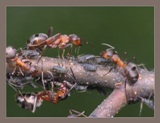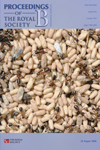|
6. ЭКОЛОГИЧЕСКИЕ ПОСЛЕДСТВИЯ взаимодействий муравьи-равнокрылые, вовлекающих аборигенных муравьев против ИНВАЗИВНЫХ ВИДОВ МУРАВЬЕВ
Ecological consequences of ant–hemipteran interactions involving native ants versus invasive ants
Степень защиты, обеспечиваемая муравьями, разводимым ими же равнокрылым "коровам" варьирует среди нативных видов муравьев, прежде всего вследствие различий среди разновидностей в агрессивности и территориальности (Bristow 1984; Buckley & Gullan 1991; Kaneko 2003; Novgorodova 2005). Учитывая, что более агрессивные разновидности муравьев с более сильно защищенными территориями обеспечивают большую защиту сосущим соки равнокрылым, то можно ожидать что эти виды муравье сильнее влияют на общую структуру сообщества и на жизнепсособность растений-хозяев. We are unaware of any studies that have compared the effects of ant–hemipteran interactions involving different native ant species on arthropod community structure, but a few studies suggest that more aggressive ant species have stronger indirect effects on plants. For example, Sipura (2002) compared the effects of the interactions between aphids and two native ant species on the herbivory and growth of two willow species and found that only the more aggressive ant species had measurable effects on plant growth.
Инвазивные виды муравьев, интродуцированные в новые местообитания, имеют две черты, позволяющие им захватывать все новые иновые территории: это их чрезвычайная агрессивность и и большое обилие и массовость семей (Holway et al. 2002). Инвазивные виды муравьев также весьма привлекаются сосущими равнокрылыми насекомыми и быстро и в больших количествах мобилизуются в места конценрации тлей и т.д., из которых они оттесняют аборигенные виды муравьв (Holway et al. 2002; Lach 2003; Ness & Bronstein 2004). Indeed, exploitation of hemipteran honeydew and plant extrafloral nectar is hypothesized to contribute to the ecological dominance of invasive ants (Holway et al. 2002). Хотя инвазивные виды муравьв могут локально снижать численность и разнообразие членистоногих (Holway et al. 2002), только одна работа иследовала прямой и непрямой эффекты взаимодействий "муравьи-тли" с участием инвазивных муравьев на межвидовые интеракции внутри пищевых сетей членистоногих (Kaplan & Eubanks 2005; see §3).
Дополнительно, немного данных и работ существует, которые оценивают последствия взаимодействий "муравьи-равнокрылые" с учатием инвазиных видов на растения (table 1). Инвазивные виды муравьев могут приводить к локальным вспышкам численности равнокрылых сосущих насекомых (Holway et al. 2002; Ness & Bronstein 2004). Однако, вследствие их изобилия, агрессивности и территориальности, инвазивные муравьи могут обеспечить сравнительно большую защиту растениям от других фитофагов, чем это делают аборигенные виды муравьев (Holway et al. 2002; Lach 2003; but see Rapp & Salum 1995). Например, Way et al. (1999) наблюдал, что опад листьев (дефолиация) сосны Pinus pinaster гусеницами of the pine processionary moth (Thaumetopoea pityocampa) был небольшой до незначительного на деревьях, патрулируемых Аргентинским инвазивным муравьем (Linepithema humile), но был умеренным до сильного на деревьях, патрулируемых несколькими аборигенными видами муравьев. The authors suggested that aggregations of honeydew-producing aphids facilitated protection of pines by L. humile, but they did not specifically test whether ant predation was actually greater in the presence of aphids than in their absence. Facultative mutualisms between the invasive ant S. invicta and aphids in tomato can harm plants by increasing the severity of infection by a plant virus (Cooper 2005), but can benefit plant reproduction in cotton by increasing ant suppression of more damaging herbivores (Styrsky 2006; Styrsky & Eubanks in preparation). Whether the effects of S. invicta in these systems differ from those by native aphid-tending ants is unknown.

Тли и Formica rufa.
(Фото: П.Корзунович >>>)
7. ПОЧЕМУ ТАК МАЛО ИНФОРМАЦИИ относительно таких вездесущих и потенциально важных взаимодействий?
Why so little information on such ubiquitous and potentially important interactions?
Несмотря на их вездесущность в земных общинах, мутуалистические взаимодействия между муравьями и создающими медвяную росу равнокрылыми насекомыми получили относительно маленькое внимание в терминах их эффектов на динамику пищевых сетей и тритрофических взаимодействий, вовлекающие их растения-хозява. Этот недостаток информации относительно экологических последствий взаимодействий "муравьи-равнокрылые" потенциально представляет главную пустоту в нашем понимании динамики сложных трофических взаимодействий в сообществах членистоногих. Этот обзор литературы показывает, что взаимодействия "муравьи-равнокрылые" могут широко затронуть местное изобилие и распределение специалистови универсалов среди хищников и среди паразитоидов, так же как и фитофагов в нескольких кормовых гильдиях. In addition, though some evidence shows that ant–hemipteran interactions result in a net decrease in the fitness of their host plants, a majority of studies document an indirect positive effect in which hemipteran-tending ants protect host plants from other, more damaging, herbivores. Since the broad ecological effects of hemipteran-tending ants as predators are precipitated by their interaction with hemipterans (i.e. ant effects would not be as strong in the absence of honeydew-producing hemipterans), ant–hemipteran interactions may represent ‘keystone interactions’ in many communities.
Почему же тогда, имеющие важные экологические последствия отношения муравьев и равнокрылых так мало исследованы? We suggest that in many systems, the effects of mutualistic interactions between ants and honeydew-producing hemipterans, either positive or negative, are often assumed without ever being quantified. A mutualistic interaction between the invasive ant Pheidole megacephala and the grey pineapple mealy bug (Dysmicoccus neobrevipes), for instance, is thought to severely damage pineapple trees in Hawaii, because the mealy bug vectors a devastating phytopathogen (Beardsley et al. 1982). Whether the interaction per se actually reduces plant fitness (i.e. whether ant-tending exacerbates the negative effects of the mealy bugs), however, has not been tested. Similarly, Way et al. (1999) surmise that the protection of pine trees by the ant L. humile is partly a consequence of ant attendance on aphids, but they never specifically test this hypothesis. In observational studies such as these (of which there are many), the assumed consequences of the ant–hemipteran interactions may very well be real, but the lack of empirical data precludes any definitive conclusions or generalizations.
Авторы также утверждают, что экологические эффекты муравьев и их взаимодействий с другим членистоногими просто игнорируются. Муравьи часто отмечаются как массовые хищники, особенно в ежегодно обновляемых агроэкосистемах (annual agricultural systems), но значение их взаимодействий с другим членистоногими часто не количественно не оценивается. Several ant species, for example, tend the recently introduced aphid Aphis glycines in soybean (Glycine max) in North America (Ragsdale et al. 2004; Styrsky & Eubanks in preparation), but no effort has been made to determine the consequences of these interactions to the abundance and distribution of other natural enemies and herbivores, or to soybean yield. The ecological consequences of ant–hemipteran interactions are also often dismissed, because they are assumed to be too local or too ephemeral to affect community structure or plant fitness. However, Wimp & Whitham (2001) showed that the local effects of an ant–aphid interaction on the abundance and distribution of arthropods on individual trees also influenced arthropod abundance and diversity throughout the surrounding plant community. Further, populations of some honeydew-producing hemipteran taxa (e.g. aphids) may indeed be ephemeral, but even short-term ant–hemipteran associations can have dramatic community-level consequences, as demonstrated by Floate & Whitham (1994) and Kaplan & Eubanks (2005; see §3). Ephemeral ant–hemipteran interactions may even induce long-term changes in host plant quality that affect other herbivores and their interactions with natural enemies later in the season (cf. Van Zandt & Agrawal 2004).
ч.1 - Введение,
ч.2 - Методика и Влияние симбиоза "муравьи-равнокрылые" на структуру и разнообразие сообщества,
ч.3 - Влияние симбиоза на растения,
ч.4 - А что получают сами растения? Список 11 факторов,
ч.5 - Влияние инвазивных видов муравьев,
ч.6 - Выводы и литература
***
|


